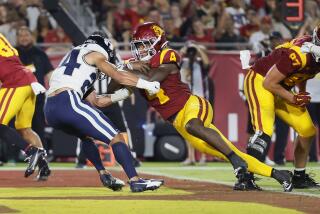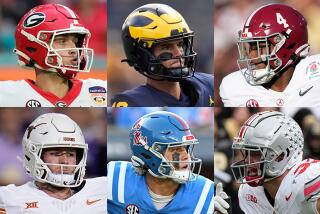Get ready for a Bunch of Crazy Stuff to hit college football
- Share via
The Mercury Astronauts were introduced in 1959, graced the cover of Life Magazine, conquered space and were mythologized in film.
This week we re-introduce you to the star-dudded Space Cadets of the Bowl Championship Series -- they’re out of this world, slightly covered in film.
As popular as Mercury . . . poisoning.
Sunday marks the 12th annual unveiling of the BCS standings, which have revolutionized, mesmerized, polarized and some say jeopardized college football -- but they aren’t any time soon going to the moon’s dark side.
The cast has changed significantly since the first BCS standings in 1998 rolled off Southeastern Conference Commissioner Roy Kramer’s press.
The first formula involved only three computers, including a New York Times index offering all the BCS news that was fit to spit. The Grey Lady finally got wise and bailed out for good after 2003.
The Associated Press poll, founded in 1936, lent its name to the formula for six years before, in 2004, issuing a “cease and desist” order in the bloody voting aftermath of the Texas-California quartile battle for a Rose Bowl bid.
The AP, a news organization, claimed it was “shocked” to learn it was part of the BCS and how dare this stink hole besmirch its good name. That was the AP news bulletin. The PM story had quotes.
There are six computers used now in a three-part formula that includes the USA Today coaches’ poll and, replacing the AP, the Harris Interactive Index.
The first-ever No. 1 team in BCS standings, Oct. 26, 1998?
That was -- grab the hand rails -- UCLA, which spent one week on top and then went into a decline that has extended through Saturday’s 24-10 home loss to Oregon.
The BCS has been around long enough to have its own archives division.
You want bizarre?
Florida and Louisiana State, which have each won two BCS titles, have spent a combined two weeks at No. 1.
Florida has never been No. 1 in the regular-season standings -- although that may change Sunday. The Gators won both of their BCS titles, in 2006 and 2008, after slipping into the No. 2 qualifying spot in the final standings release.
LSU won in 2003 without reaching No. 1 and spent only two weeks on top in 2007, falling all the way to seventh before a miraculous last-weekend ascent from No. 7 to No. 2.
Oklahoma has been ranked No. 1 a record 18 times, with only the 2000 title to show for it. Ohio State owns the consecutive-weeks-at-No. 1 record with 12. Texas leads the nation in BCS standings appearances at 77.
Schools with most weeks spent at No. 1 without winning the title: Alabama and Nebraska, at five.
Why the BCS?
That’s what some members of Congress are itching to know.
There’s no simple way to explain it other than to say college football was a worse mess before the BCS. Before 1998, with bowls cutting their own deals with conferences, it took a chance interlude for No. 1 and No. 2 to meet.
Take 1997: No. 1 Michigan couldn’t play No. 2 Nebraska for the national title because Michigan was contractually bound to play Washington State in the Rose Bowl. The result was a Michigan/Nebraska title split.
The BCS concept involved the Rose Bowl loosening its alliance to allow a formulated 1-2 matchup in a designated “championship” game.
Has it ever worked out swell . . . most years . . . OK, once or twice?
Eleven seasons later, here we are, still arguing about BCS unfairness, anti-trust, the attention span of voters, and a playoff.
Reality: The BCS will be around at least through 2013, and maybe beyond. College presidents are more likely to revert to the old bowl system rather than rubber stamp anything that involves seeding and a bracket.
In spite of the BCS, college football is more popular than ever. CBS and ESPN recently signed multi-billion dollar deals to televise Southeastern Conference games, ushering in what Commissioner Mike Slive has labeled the SEC’s “golden age.”
Thumbnails on the players in this year’s production:
USA Today coaches’ poll
What to watch for: Guys who profess to be molders of young men hiding behind their desks. The coaches, for years, insisted on keeping their votes anonymous.
They were forced out of the dark in 2005, and even then Ohio State’s Jim Tressel abstained from his final vote in 2006 so as to not reveal what he thought of Michigan.
The coaches, last off-season, commissioned a survey service to tell them their poll should be anonymous again, starting in 2010. But that won’t fly in this age of threatened lawsuits, so look for the coaches to call a reverse.
Harris poll
What to watch for: Harris was created out of thin air in 2005 to replace the AP as part of the BCS formula. With an eclectic panel of 114, composed of former coaches, media members, broadcasters, it’s the larger body of the BCS government -- its House of Representatives.
At first (it seemed) Harris let anyone in -- taxi drivers, taxidermists, doughnut makers, longshoremen -- but it has since streamlined operations to the point where you only mildly chuckled this week when someone gave points to Tennessee.
Computers
What to watch for: your eyelids to droop.
It has been the same six indexes since 2004: Sagarin, Colley, Massey, Billingsley, Anderson & Hester and Wolfe.
Methodology: mysterious, we’re left to trust what they’re doing is beyond reproach. Last week, for example, the five BCS computers in production had LSU at No. 1 even though anyone who saw the Tigers play against Mississippi State or Georgia knew they were borderline top-10 material.
And then Florida came to Baton Rouge and proved it.
The stage is set for first BCS Sunday. What could possibly go wrong this year other than everything?
--
twitter.com/DufresneLATimes
More to Read
Go beyond the scoreboard
Get the latest on L.A.'s teams in the daily Sports Report newsletter.
You may occasionally receive promotional content from the Los Angeles Times.











